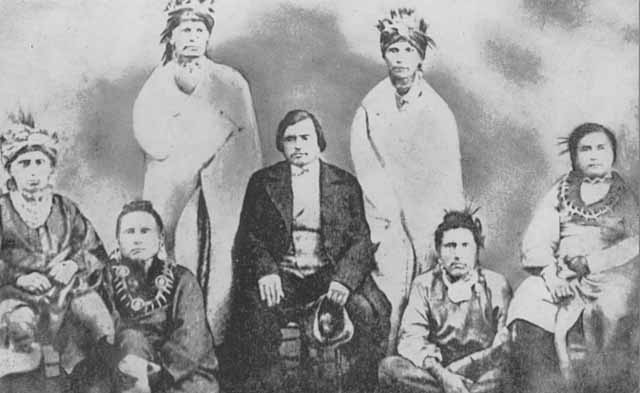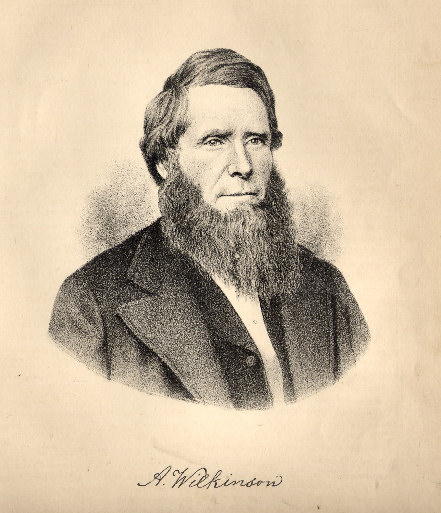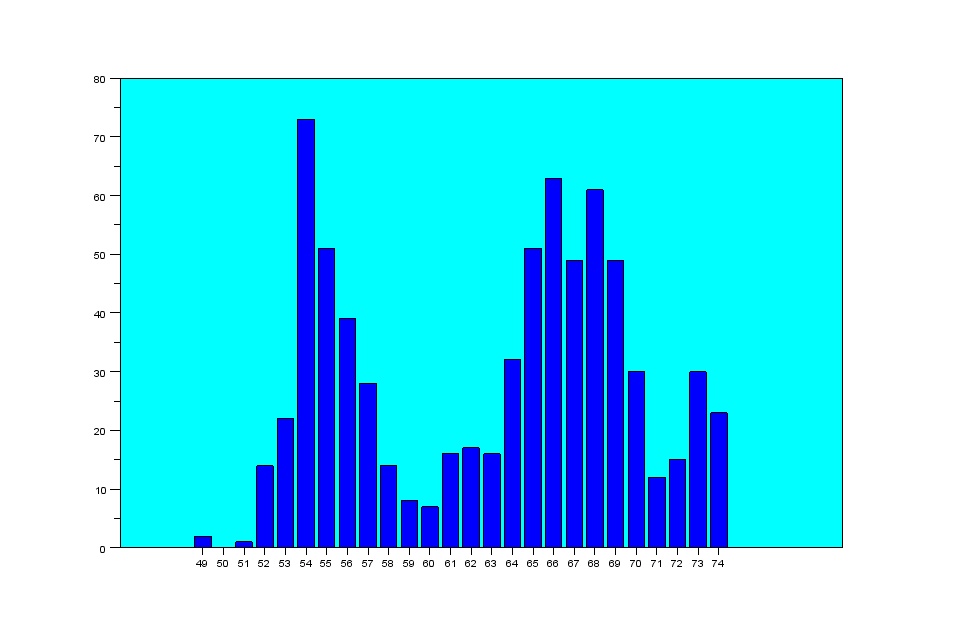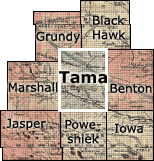Written by William Haloupek.
Prehistory
The region now known as
Iowa has been inhabited for at least
13,000 years. It is difficult or
impossible to determine which tribes
lived in which areas at which times.
Estimates of Native American population
numbers before 1900 vary widely. Part of
the problem is that, by the time anyone
started counting them, the populations
were already greatly in flux, due to
warfare, disease and forced migration.
The population of what is now the
Continental United States, in 1492, has
been estimated as low as 1 million, and
as high as 10 million. At that time,
most of the people in the Western
Hemisphere lived in what we now call
Mexico and Central America. The Tama
County population was probably in the
1,000-2,000 range. I would offer a wild
guess, that the population fluctuated
between 0 and 2,000 for 13,000 years
before 1492.
History
At the start of the 19th Century, what
is now central Iowa, including Tama
County, was inhabited by the Iowa Tribe
(also spelled Ioway, but they called
themselves Baxoje), for whom the state
was named. In 1803 the US bought a large
amount of land, including all of Iowa,
from Napoleon, Emperor of France, in a
deal called the Louisiana Purchase. The
Iowa people were visited by Lewis and
Clark in 1804. Their 1760 population has
been estimated at 1,100. Decimated by
smallpox, the Iowa Tribe was forced onto
reservations in Kansas and Nebraska in
1824-1836.
By 1900, the Native American
population of the US had fallen below
250,000. At the same time, the total
US population had grown to more than
76 million. Tama County grew from near
zero in 1850 to over 5,000 in 1860,
and almost 25,000 in 1900. Whatever
else you can say about the different
cultures, one key aspect of the
European "invasion" was that a very
sparse native population was replaced
by a much denser white population.
With 25,000 people in 720 square
miles, Tama County had a population
density of 35 people per square mile,
in 1900. This would hardly be
considered crowded, by modern
standards, but it was much more
crowded than it had ever been in
pre-Columbian times.

Mesquakie Indians responsible for
the establishment of the Meskwaki
Settlement at Tama, Iowa in 1857.
The Fox Tribe (they call themselves
Meskwaki), had originated along the
Saint Lawrence River, in what is now
Ontario. They were coerced,
encouraged, and pressured to move
westward, and lived in Iowa from 1830
to 1843, when they were ordered to
move to a reservation in Kansas. Many
refused to leave, and in 1851 a law
was passed allowing them to purchase
land in Iowa. In 1857 the Meskwaki
bought some land in Tama County, where
many of them (1,327 in the 2010 US
Census) still live. They now own one
of the largest casinos in the Midwest,
in Indian Village Township, between
Montour and Tama. From Chapter
III in The History of Tama
County, 1883:
As to the present condition
of the Indians, the
following, which is an
extract from
the report by U. S. Agent
Geo. L. DAVENPORT, in
August, 1881, treats at
length:
"According to the census
taken of this tribe last
winter, they number
91 men, 104 women, 77 girls
and 83 boys. Population in
all 355."
|
The section of Iowa containing Tama
County was opened for pioneer
settlement in 1845, but the first
permanent settlers did not arrive in
Tama County until 1849. From Chapter
IV in The History of Tama
County, 1883:
According to the dates given
the historian, the first to
locate in the territory
now comprising Tama county,
with a view to secure a
permanent home, was the
Vandorin party, who came
from Henry county, and
settled in York township May
21, 1849.
The principal part of the
little colony was William
Riley Vandorin, his wife
Rachel
and two children. With them
came two hired men, James
Vandorin and Isaac McKern;
Ephraim Whittaker also came
with his wife and two
children.
|
The two hired men went back to Henry
County, and Ephriam Whittaker built a
cabin about 5 miles from the
Vandorins. Thus Tama County had two
first families: the Vandorin family of
four, in York Township, and the
Whittaker family of four, in Salt
Creek Township. Settlers came by the
hundreds at first, and then by the
thousand, reaching 5,285 by 1860.
The Wilkinson family settled in Salt
Creek Township, in 1849. The family
consisted of the mother and six grown
offspring: Anthony, Robert, William,
Rebecca, Jane and Mary.
Isaac and Martha (Greer) Asher and
their 9 children had settled in
Marshal County in 1847, where a 10th
child was born. The family moved to
Indian Village Township, Tama County,
in November 1849. The 8 people listed
in the 1850 US Census for Tama County
were members of the Asher family.

Anthony Wilkinson, b. 28 July 1817,
in Donegal, Ireland
The 1852 Iowa State Census lists 52
families, and the 1854 Iowa State Census
lists 229 families, in Tama County. See
the Census
page.
The 1875
Business Directory provides some
insight into the population in the
first 25 years of settlement. Although
it lists each business, including
farms, and some have more than one
owner, it also lists nativity and year
settled in Tama County, which would
apply to the owners individually.
Also, those few businesses that had
more than one owner were generally the
ones that didn't include nativity and
year settled. For simplicity, we count
each business as one person, without
too much error. There are many caveats
one should make before using these
data to draw any conclusions. However,
it is of interest to see how the
numbers come out.
Of the 751 businesses listed, at least
502, or about two-thirds, were farms.
The Wilkinson brothers, Robert,
Anthony and William, had come to Tama
County in 1849, and were still farming
in 1875. The Directory for Salt Creek
Township lists A. Wilkinson in Section
20, and W. Wilkinson in Scetion 29,
but misses a large estate in Section
19, under the name Robt. Wilkinson.
Settlement by Year

The graph shows the number of
businesses owned in 1875, by
people who came to Tama County in
each year, from 1849 to 1974. It
appears that early settlement of
Tama County occurred in two waves.
As one might expect, settlement
slowed during the Civil War years.
What may be surprising is that the
first wave had begun to subside
years before the start of the War,
and the second wave began well
before the end of the War. The low
in 1871 may represent the time
when all the land had been
claimed, under the Land Act.
Settlers' Nativity

This shows the number of
businesses whose owners were
born in each state and foreign
country. The vast majority
were born in US states to the
east of Iowa, from
Massachusetts to Illinois.
There were 21 from Canada, and
the rest were born in Western
Europe. Only 10 came from
Bohemia; in another two
decades, Tama County would be
flooded with Bohemian
immigrants, and even more from
Germany and the rest of
Europe. (The bar marked USA
represents all US states
besides those already listed.)
The data:
| OH |
156 |
VA |
6 |
Canada |
21 |
| NY |
110 |
IA |
5 |
Germany |
55 |
| PA |
91 |
MI |
5 |
Scotland |
34 |
| IN |
42 |
NC |
4 |
England |
25 |
| VT |
28 |
WV |
2 |
Ireland |
19 |
| IL |
17 |
DE |
2 |
Bohemia |
10 |
| NH |
14 |
WI |
1 |
France |
3 |
| CT |
14 |
MO |
1 |
Denmark |
1 |
| MA |
10 |
GA |
1 |
Moravia |
1 |
| ND |
9 |
DC |
1 |
Sweden |
1 |
| ME |
9 |
TN |
1 |
Switzerland |
1 |
| KY |
8 |
Gen US |
2 |
Total foreign |
171 |
| NJ |
8 |
Total US |
547 |
Total |
718 |
There were 5 business owners in
1875 who had been born in Iowa,
and one, Chester Guernsey, was
born in Tama County, 1856. He
would have been 19 years old,
and owned his own farm.
As the US Census data shows,
the European population
increased dramatically in the
second half of the 19th
Century, raching a maximum of
almost 25,000 in 1900, and
slowly declined to less than
18,000 today.
| 1850 |
1860 |
1870 |
1880 |
1890 |
1900 |
1910 |
1920 |
1930 |
1940 |
1950 |
1960 |
1970 |
1980 |
1990 |
2000 |
2010 |
| 8 |
5,285 |
16,131 |
21,585 |
22,052 |
24,585 |
22,156 |
21,861 |
21,987 |
22,428 |
21,688 |
21,413 |
20,147 |
19,533 |
17,419 |
18,103 |
17,767 |
US Census Data for Tama
County, Iowa. Data obtained
from State Library of Iowa
The US Census did not include
Native Americans until 1890,
and even then, it only
included those that were
taxed.
In addition to the federal
censuses, Tama County was
included in most of the
censuses conducted by the
state of iowa. The totals for
the state censuses before 1880
are listed in Chapter
VI of The History of
Tama County, 1883:
| 1852 |
1854 |
1856 |
1859 |
1863 |
1865 |
1867 |
1869 |
1873 |
1875
|
| 262 |
1,163 |
3,520 |
5,346 |
7,027 |
7,882 |
11,165 |
14,243 |
16,343 |
18,771 |
Cities in
Tama County
Dozens of cities and towns
have come and gone in Tama
County. Take a look at Hamlets
and Villages that no longer
exist in Tama County Iowa.
This map
from 1916 shows the
townships in their current
configuration. Note: the
town of Berlin is now called
Lincoln.
There are currently 21
townships and 12 "cities" in
Tama County. The city
population totals, according
to the latest data from the
Iowa League of Cities are
shown below.
| city |
township |
pop
|
| Chelsea |
Salt Creek |
267
|
| Clutier |
Oneida |
213
|
| Dysart |
Clark |
1,379
|
| Elberon |
York |
196
|
| Garwin |
Carlton |
527
|
| Gladbrook |
Spring Creek |
945
|
| Lincoln |
Lincoln |
162
|
| Montour |
Indian Village |
249
|
| Tama |
Tama |
2,877
|
| Toledo |
Toledo |
2,341
|
| Traer |
Perry |
1,703
|
| Vining |
York |
50
|
The sum of the city
populations is 10,909, about
61% of the current
population. The remaining
39% live in rural areas.
Surrounding
Area

| County |
Population
in 1850 |
Population
in 1900 |
Population
in 2010 |
| Benton |
672 |
25,177 |
26,076
|
| Black Hawk |
135 |
32,399 |
131,090
|
| Grundy |
0 |
13,757 |
12,453
|
| Iowa |
822 |
19,544 |
16,355
|
| Jasper |
1,280 |
26,976 |
36,842
|
| Marshall |
338 |
29,991 |
40,648
|
| Poweshiek |
615 |
19,414 |
18,914
|
| Tama |
8 |
24,585 |
17,767 |
In 1850, the counties to
the south and east of Tama
were well populated. By
1900, the population had
leveled somewhat. In the
period from 1900 to 2010,
there was a mass migration
from rural areas to
cities, and the
Waterloo/Cedar Falls
metropolitan area, in
Black Hawk County, grew to
be the largest in the
area. The cities of
Newton, in Jasper County,
and Marshalltown, in
Marshall County, also
showed growth.
Demographically, present
day Tama County can be
described as a mainly
rural area, just south of
Waterloo.
Page updated 12 Jul 2013
by Tama County
Coordinator.
|